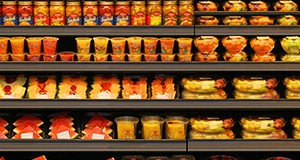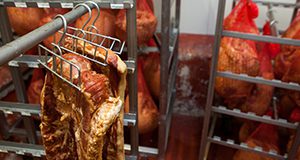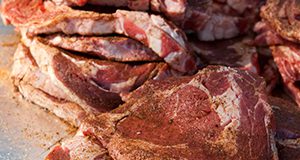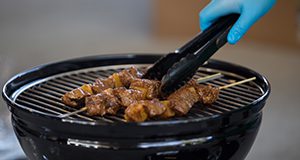The Florida 4-H Poultry BBQ program has existed for years, and the program for red meat cookery has been a huge success in Tennessee 4-H. With sponsorship for the winners at the state level, the Florida 4-H Tailgate Contest program will be a success in Florida as well. This program will strive to promote enjoyable outdoor cooking experiences, encourage the incorporation of animal protein in the diet in order to combat childhood obesity, improve youth nutritional knowledge and cooking skills, and impart knowledge about safe handling and proper degree of doneness to produce safe and delicious meat dishes. This 2-page fact sheet is the fourth publication in the Florida 4-H Tailgate series, and it discusses smoking and slow cooking meat. Written by Chad Carr, Brian Estevez, Sonja Crawford, Jason Scheffler, George Baker, Ed Jennings, and Mark Mauldin, and published by the 4-H Youth Development Department, December 2016.
http://edis.ifas.ufl.edu/4h375
Tag: Healthy Cooking
Florida 4-H Tailgate: Cooking Safety
The Florida 4-H Poultry BBQ program has existed for years, and the program for red meat cookery has been a huge success in Tennessee 4-H. With sponsorship for the winners at the state level, the Florida 4-H Tailgate Contest program will be a success in Florida as well. This program will strive to promote enjoyable outdoor cooking experiences, encourage the incorporation of animal protein in the diet in order to combat childhood obesity, improve youth nutritional knowledge and cooking skills, and impart knowledge about safe handling and proper degree of doneness to produce safe and delicious meat dishes. This 3-page fact sheet is the second publication in the Florida 4-H Tailgate series, and it addresses cooking safety. Written by Chad Carr, Brian Estevez, Sonja Crawford, Jason Scheffler, George Baker, Ed Jennings, and Mark Mauldin, and published by the 4-H Youth Development Department, December 2016.
http://edis.ifas.ufl.edu/4h373
Florida 4-H Tailgate: Cooking Equipment
The Florida 4-H Poultry BBQ program has existed for years, and the program for red meat cookery has been a huge success in Tennessee 4-H. With sponsorship for the winners at the state level, the Florida 4-H Tailgate Contest program will be a success in Florida as well. This program will strive to promote enjoyable outdoor cooking experiences, encourage the incorporation of animal protein in the diet in order to combat childhood obesity, improve youth nutritional knowledge and cooking skills, and impart knowledge about safe handling and proper degree of doneness to produce safe and delicious meat dishes. This 2-page fact sheet is the first publication in the Florida 4-H Tailgate series, and it discusses cooking equipment. Written by Chad Carr, Brian Estevez, Sonja Crawford, Jason Scheffler, George Baker, Ed Jennings, and Mark Mauldin, and published by the 4-H Youth Development Department, July 2016.
http://edis.ifas.ufl.edu/4h372
Healthy Eating: Improving Your Convenience Foods
 Convenience foods are foods that require little preparation. Some convenience foods only require heating and are ready to eat in less than five minutes! The majority of convenience foods are processed foods. However, precut, prewashed, frozen, and canned fruits and vegetables also can be classified as convenience foods. They are healthy foods but are usually more expensive than less prepared fresh fruits and vegetables. This 2-page fact sheet is a major revision that discusses pros and cons of convenience foods, improvement of nutritional quality, common convenience foods and easy additions, and additional tips. Written by Emily Minton and Linda B. Bobroff, and published by the UF Department of Family, Youth and Community Sciences, revised March 2016.
Convenience foods are foods that require little preparation. Some convenience foods only require heating and are ready to eat in less than five minutes! The majority of convenience foods are processed foods. However, precut, prewashed, frozen, and canned fruits and vegetables also can be classified as convenience foods. They are healthy foods but are usually more expensive than less prepared fresh fruits and vegetables. This 2-page fact sheet is a major revision that discusses pros and cons of convenience foods, improvement of nutritional quality, common convenience foods and easy additions, and additional tips. Written by Emily Minton and Linda B. Bobroff, and published by the UF Department of Family, Youth and Community Sciences, revised March 2016.
http://edis.ifas.ufl.edu/fy1312
Eating Defensively: The Nutrition and Food Safety Benefits of Cooked Produce
 Current nutrition trends such as the “raw food diet” may lead consumers to believe that raw leafy vegetables are more nutritious than cooked vegetables, despite research showing that cooked vegetables make important nutritional contributions. This publication describes the nutrient retention and quality of cooked vegetables, explains why cooking vegetables is appropriate for consumers with food safety concerns, and provides tips for preparing cooked vegetables. This 4-page fact sheet was written by Morgan Dehnard, Amy Simonne, and Gail P. A. Kauwell, and published by the UF Department of Family Youth and Community Sciences, October 2013.
Current nutrition trends such as the “raw food diet” may lead consumers to believe that raw leafy vegetables are more nutritious than cooked vegetables, despite research showing that cooked vegetables make important nutritional contributions. This publication describes the nutrient retention and quality of cooked vegetables, explains why cooking vegetables is appropriate for consumers with food safety concerns, and provides tips for preparing cooked vegetables. This 4-page fact sheet was written by Morgan Dehnard, Amy Simonne, and Gail P. A. Kauwell, and published by the UF Department of Family Youth and Community Sciences, October 2013.
http://edis.ifas.ufl.edu/fy1395
Preparing Healthful Ethnic Foods (FCS8757/FY343)
 Eating a variety of nutrient-rich foods helps you get the nutrients you need to look and feel your best. One tasty way to increase variety in your food choices is to include ethnic foods like Chinese, Mexican, Italian, Greek, and others. How do you know that you are making healthy choices when you eat these foods? This 3-page fact sheet was written by Linda B. Bobroff and R. Elaine Turner, and published by the UF Department of Family Youth and Community Sciences, June 2012.
Eating a variety of nutrient-rich foods helps you get the nutrients you need to look and feel your best. One tasty way to increase variety in your food choices is to include ethnic foods like Chinese, Mexican, Italian, Greek, and others. How do you know that you are making healthy choices when you eat these foods? This 3-page fact sheet was written by Linda B. Bobroff and R. Elaine Turner, and published by the UF Department of Family Youth and Community Sciences, June 2012.
http://edis.ifas.ufl.edu/fy343
Alimentación Saludable: Sugerencias para ensaladas (FCS8696Span/FY703)
 ¡Las ensaladas son rápidas y fáciles de preparar y tienen infinidad de opciones! Las ensaladas son una comida práctica y saludable, acompáñelas con galletas integrales o con pan de trigo. Pruebe algunas de estas opciones en su próxima ensalada. This is the Spanish Language version of Healthy Eating: Salad Suggestions. Written by Jennifer Hillan and Emily Minton, and published by the UF Department of Family Youth and Community Sciences, May 2012.
¡Las ensaladas son rápidas y fáciles de preparar y tienen infinidad de opciones! Las ensaladas son una comida práctica y saludable, acompáñelas con galletas integrales o con pan de trigo. Pruebe algunas de estas opciones en su próxima ensalada. This is the Spanish Language version of Healthy Eating: Salad Suggestions. Written by Jennifer Hillan and Emily Minton, and published by the UF Department of Family Youth and Community Sciences, May 2012.
http://edis.ifas.ufl.edu/fy703
Healthy Eating: Salad Suggestions (FCS8696/FY702)
 Salads are quick and easy to make and have endless possibilities! Paired with whole grain crackers or whole wheat bread, salads make healthy and convenient meals. Try some of the ideas this 2-page fact sheet for your next salad. Written by Jennifer Hillan and Emily Minton, and published by the UF Department of Family Youth and Community Sciences, May 2012.
Salads are quick and easy to make and have endless possibilities! Paired with whole grain crackers or whole wheat bread, salads make healthy and convenient meals. Try some of the ideas this 2-page fact sheet for your next salad. Written by Jennifer Hillan and Emily Minton, and published by the UF Department of Family Youth and Community Sciences, May 2012.
http://edis.ifas.ufl.edu/fy702
Alimentación Saludable: Recetas que no requieren cocción (FCS8693Span/FY695)
 Pruebe estas recetas rápidas y fáciles de preparar para comidas saludables y balanceadas. ¡No hay necesidad de cocinar! This 2-page fact sheet was written by Jennifer Hillan y Emily Minton, and published by the UF Department of Family Youth and Community Sciences, May 2012.
Pruebe estas recetas rápidas y fáciles de preparar para comidas saludables y balanceadas. ¡No hay necesidad de cocinar! This 2-page fact sheet was written by Jennifer Hillan y Emily Minton, and published by the UF Department of Family Youth and Community Sciences, May 2012.
http://edis.ifas.ufl.edu/fy695
Healthy Eating: No-Cook Recipes (FCS8693/FY694)
 Try these quick, easy recipes for balanced, healthy meals. No cooking required! This 2-page fact sheet was written by Jennifer Hillan and Emily Minton, and published by the UF Department of Family Youth and Community Sciences, May 2012.
Try these quick, easy recipes for balanced, healthy meals. No cooking required! This 2-page fact sheet was written by Jennifer Hillan and Emily Minton, and published by the UF Department of Family Youth and Community Sciences, May 2012.
http://edis.ifas.ufl.edu/fy694
Keeping Food Safe: Preparing and Cooking (FCS80001/FY1288)
 Food preparation and cooking can be fun and rewarding for many reasons. Well-prepared meals can save money and meet nutritional needs, and making safe and healthy meals a part of your lifestyle can contribute to lower healthcare costs. But many people with busy schedules find it difficult to make time to cook meals. And when we are rushed, we may not pay close attention to good food safety practices. It is very important to follow food safety guidelines during food preparation and cooking in order to reduce the risk of foodborne illness for you and your loved ones. Read this 3-page fact sheet to learn more about food safety during food preparation and cooking. Written by Claudia Peñuela and Amarat Simonne and published by the UF Department of Family Youth and Community Sciences, March 2012.
Food preparation and cooking can be fun and rewarding for many reasons. Well-prepared meals can save money and meet nutritional needs, and making safe and healthy meals a part of your lifestyle can contribute to lower healthcare costs. But many people with busy schedules find it difficult to make time to cook meals. And when we are rushed, we may not pay close attention to good food safety practices. It is very important to follow food safety guidelines during food preparation and cooking in order to reduce the risk of foodborne illness for you and your loved ones. Read this 3-page fact sheet to learn more about food safety during food preparation and cooking. Written by Claudia Peñuela and Amarat Simonne and published by the UF Department of Family Youth and Community Sciences, March 2012.
http://edis.ifas.ufl.edu/fy1288
Healthy Eating: Salad Suggestions (FCS8696/FY702)
 Salads are quick and easy to make and have endless possibilities! Paired with whole grain crackers or whole wheat bread, salads make healthy and convenient meals. Try some of the ideas this 2-page fact sheet for your next salad. Written by Jennifer Hillan and Emily Minton, and published by the UF Department of Family Youth and Community Sciences, October 2011.
Salads are quick and easy to make and have endless possibilities! Paired with whole grain crackers or whole wheat bread, salads make healthy and convenient meals. Try some of the ideas this 2-page fact sheet for your next salad. Written by Jennifer Hillan and Emily Minton, and published by the UF Department of Family Youth and Community Sciences, October 2011.
http://edis.ifas.ufl.edu/fy702
Alimentación Saludable: Sugerencias para ensaladas (FCS8696Span/FY703)
 ¡Las ensaladas son rápidas y fáciles de preparar y tienen infinidad de opciones! Las ensaladas son una comida práctica y saludable, acompáñelas con galletas integrales o con pan de trigo. Pruebe algunas de estas opciones en su próxima ensalada. This is the Spanish Language version of Healthy Eating: Salad Suggestions. Written by Jennifer Hillan and Emily Minton, and published by the UF Department of Family Youth and Community Sciences, October 2011.
¡Las ensaladas son rápidas y fáciles de preparar y tienen infinidad de opciones! Las ensaladas son una comida práctica y saludable, acompáñelas con galletas integrales o con pan de trigo. Pruebe algunas de estas opciones en su próxima ensalada. This is the Spanish Language version of Healthy Eating: Salad Suggestions. Written by Jennifer Hillan and Emily Minton, and published by the UF Department of Family Youth and Community Sciences, October 2011.
http://edis.ifas.ufl.edu/fy703
Perfect Meals with Pressure Cooking (FCS8995/FY1270)
Preparing great tasting, healthy meals can be a time consuming task, but pressure cooking is a great way to prepare them in just minutes. Although they may seem old fashioned, pressure cookers are making a comeback, especially with today’s busy families who are trying to save both time and money. Pressure cooking is also a healthy cooking option as it maintains the natural flavor and nutrients of food. Delicious, healthy meals are just minutes away with this handy device! This 3-page fact sheet was written by Paula G. Harris-Swiatko, Karla P. Shelnutt, and Amy Simonne, and published by the UF Department of Family Youth and Community Sciences, March 2012.
http://edis.ifas.ufl.edu/fy1270
Alimentación Saludable: Creando una comida sin tener quecocinar (FCS8692Span/FY692)
 ¿No tiene gana de cocinar? Utilice MiPlato para crear comidas balanceadas y que no necesitan cocinarse. This 1-page fact sheet was written by Jennifer Hillan y Emily Minton , and published by the UF Department of Family Youth and Community Sciences, July 2011.
¿No tiene gana de cocinar? Utilice MiPlato para crear comidas balanceadas y que no necesitan cocinarse. This 1-page fact sheet was written by Jennifer Hillan y Emily Minton , and published by the UF Department of Family Youth and Community Sciences, July 2011.
http://edis.ifas.ufl.edu/fy692
Healthy Eating: No-Cook Recipes (FCS8693/FY694)
Try these quick, easy recipes for balanced, healthy meals. No cooking required! This 1-page fact sheet was written by Jennifer Hillan and Emily Minton , and published by the UF Department of Family Youth and Community Sciences, May 2011.
http://edis.ifas.ufl.edu/fy694


